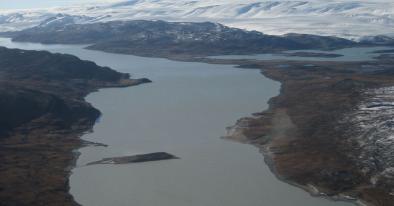Algae Are Making Greenland Darker, and That's Probably a Bad Thing

The Greenland ice sheet is getting darker, and that’s bad news for the Arctic thermostat, since darker surfaces absorb more heat. Now, a pair of scientists have concluded that in at least one section of Greenland, tiny algae play an outsized role in giving the ice its surprising shade.
Every summer, a dark area appears along the western margin of the Greenland ice sheet. Folks have mainly attributed the discoloratoin to dust and black carbon, sooty stuff released from coal-fired power plants and during wildfires.
But ice-dwelling algae, which produce dark pigments to combat the fierce solar radiation on ice sheets, could also play a role. A study published last year in Nature Communications found that across the pan European Arctic, red snow algae are so effective at turning glaciers bubblegum pink that they’re causing them to melt faster. Marek Stibal, a microbial ecologist at Charles University in Prague, wondered if ice algae could be responsible for western Greenland’s discoloration, too.
Lo and behold, it seems they are. In research published recently in Geophysical Research Letters, Stibal, along with co-author Jason Box of The Geologic Survey of Denmark, present field measurements collected over two months in 2014 along the edge of the dark area at the southwest margin of the Greenland ice sheet.
...
Overall, the researchers found that algae played a bigger role than non-living particles in reducing the ice’s albedo, and that their abundance could explain 70 percent of the variation in reflectance across the study area.
...
More algal growth—which could be triggered by melting ice (even ice algae need liquid water), and nutrient-laden dust—could result in a darker ice sheet, causing even more melting in the future. Basically, a vicious feedback loop. As a reminder, the Greenland ice sheet contains enough frozen water to raise global sea levels by nearly 25 feet. Feedback loops that cause ice to melt are generally bad for humans.
Related Content



